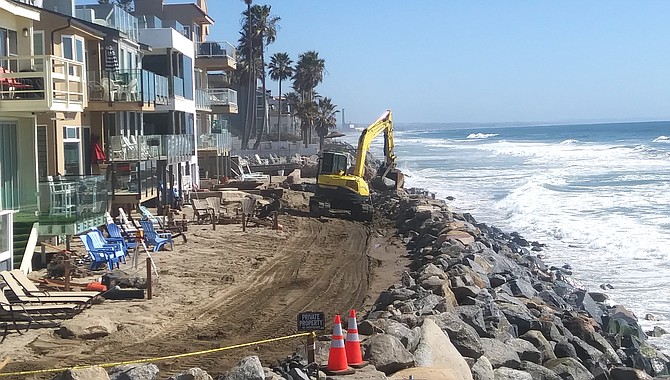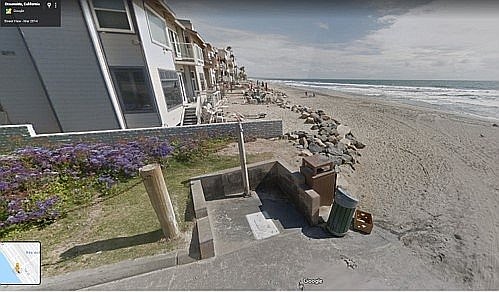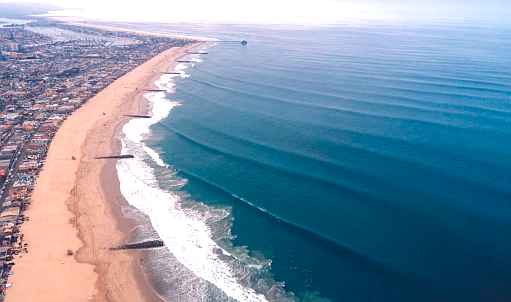 Facebook
Facebook
 X
X
 Instagram
Instagram
 TikTok
TikTok
 Youtube
Youtube

Apparently nothing will stop beachfront property owners in Oceanside from dropping in huge riprap boulders in front of their house.
Not even a stop-work order from the state coastal commission.
At about 2 pm Friday, March 5, the city of Oceanside was served with an order from the state coastal commission instructing the city to rescind its approval of the installation of new riprap in front of the seven houses from 1201 to 1213 South Pacific at the western terminus of Oceanside Boulevard. After the stop-work order was served Friday afternoon, the heavy equipment operator continued dropping new boulders and moving existing ones towards the sea with a bulldozer and giant crane. He’s been returning every day since.

On Saturday afternoon a man from Cantarini Tractor of Fallbrook admitted the stop work order was in fact served to the city of Oceanside the day before. “They were served at 2:30 in the afternoon and then they talked to their attorneys, and they got it rescinded.” He claimed the work was, “…legal. They got permits for everything.”
Not true, says Jim Jaffee of the Surfrider Foundation. “Throughout the years, private property owners in Oceanside have undertaken illegal construction activities to dump riprap further out onto the public beach, expanding their private beach at the cost of the public beach. While permits may seem like a bureaucratic issue, a crime is a crime by any name.”
Jaffee suggests Oceanside officials have established a wink-wink, nudge-nudge relationship with beachfront homeowners, while failing its obligation to the coastal commission in preserving the public beach.
“The tractors are rolling again today,” Jaffee said on Monday, March 8. “They are in violation of what the coastal commission has asked them not to do. They continue to move their private beach out. This is illegal. They are doing it without a permit. That’s why there is no public beach there anymore.”
Jaffee says private, beachfront property is expanding in Oceanside thanks to the coziness of city officials. “The city has willingly turned a blind eye by allowing the homeowner to maintain and expand their private beach without coastal development permits.”

The coastal commission sent a letter to Oceanside in March of last year claiming that a permit is required for construction equipment to be operated within 20 feet of coastal waters, and that the city-allowed riprap installation done in 2019 was not legal. “Our understanding is that the planning and engineering departments never alerted the city attorney that the city was on notice [from the coastal commission] and that they needed to stop granting these exemptions that allows the placement of all this new riprap,” Jaffee explains.
An attempt to get a response from Oceanside city attorney John Mullen was not productive.
Realtor Chris Abad is familiar with beachfront property in Oceanside. He says 1201 South Pacific, for instance, is divided into two units, and that the largest, 1850-square feet unit would probably sell for $2 million. Abad says the new riprap would “definitely” increase the value of all the homes with new riprap, even though the increase in square footage would not officially appear on documents. “The extra area may not show up on title, but all anyone would have to do is look at it to see there is more land there.”
Meanwhile, some residents are wondering why the city of Oceanside is not being completely open with its residents regarding its plans to bring more sand to its denuded beaches. Officially called “Feasibility Study for Beach Sand Replenishment/Retention Devices,” Oceanside city staffers unveiled a power point presentation in September. It showed a number of possibilities that the city may execute in order to get more sand on the two-thirds of Oceanside’s beach area north of Tyson Street that has largely gone beachless.
The plan’s options include a $12.5-million submerged artificial reef, a 350-foot extension of the South Jetty near the harbor, or the installation of 400- to 600-foot rock groins (or short jetties) similar to those installed in Newport Beach in the 1960s.
What the city did not tell the public but did in fact tell the San Diego Association of Governments (SANDAG) at its March 4 meeting was that the city has in mind 12 jetties between the pier and the southern boundary of the city at the Buena Vista Lagoon.
At its March 11 meeting, the Oceanside city council will consider applying for a shoreline erosion grant from the state department of boating and waterways. Plans call for that grant to be used for the groins and/or other sand retention projects. Jaffee says if the city does decide to apply for that grant, he will personally appear before that state of California department to try to block it. “The legislation under which these grants are given specifically excludes using the grants to be used for sand retention.”
Oceanside principal planner Russ Cunningham has been the point man for riprap installations as well as sand replenishment issues for the city of Oceanside. Attempts to get a response from him on these issues were not successful.


Apparently nothing will stop beachfront property owners in Oceanside from dropping in huge riprap boulders in front of their house.
Not even a stop-work order from the state coastal commission.
At about 2 pm Friday, March 5, the city of Oceanside was served with an order from the state coastal commission instructing the city to rescind its approval of the installation of new riprap in front of the seven houses from 1201 to 1213 South Pacific at the western terminus of Oceanside Boulevard. After the stop-work order was served Friday afternoon, the heavy equipment operator continued dropping new boulders and moving existing ones towards the sea with a bulldozer and giant crane. He’s been returning every day since.

On Saturday afternoon a man from Cantarini Tractor of Fallbrook admitted the stop work order was in fact served to the city of Oceanside the day before. “They were served at 2:30 in the afternoon and then they talked to their attorneys, and they got it rescinded.” He claimed the work was, “…legal. They got permits for everything.”
Not true, says Jim Jaffee of the Surfrider Foundation. “Throughout the years, private property owners in Oceanside have undertaken illegal construction activities to dump riprap further out onto the public beach, expanding their private beach at the cost of the public beach. While permits may seem like a bureaucratic issue, a crime is a crime by any name.”
Jaffee suggests Oceanside officials have established a wink-wink, nudge-nudge relationship with beachfront homeowners, while failing its obligation to the coastal commission in preserving the public beach.
“The tractors are rolling again today,” Jaffee said on Monday, March 8. “They are in violation of what the coastal commission has asked them not to do. They continue to move their private beach out. This is illegal. They are doing it without a permit. That’s why there is no public beach there anymore.”
Jaffee says private, beachfront property is expanding in Oceanside thanks to the coziness of city officials. “The city has willingly turned a blind eye by allowing the homeowner to maintain and expand their private beach without coastal development permits.”

The coastal commission sent a letter to Oceanside in March of last year claiming that a permit is required for construction equipment to be operated within 20 feet of coastal waters, and that the city-allowed riprap installation done in 2019 was not legal. “Our understanding is that the planning and engineering departments never alerted the city attorney that the city was on notice [from the coastal commission] and that they needed to stop granting these exemptions that allows the placement of all this new riprap,” Jaffee explains.
An attempt to get a response from Oceanside city attorney John Mullen was not productive.
Realtor Chris Abad is familiar with beachfront property in Oceanside. He says 1201 South Pacific, for instance, is divided into two units, and that the largest, 1850-square feet unit would probably sell for $2 million. Abad says the new riprap would “definitely” increase the value of all the homes with new riprap, even though the increase in square footage would not officially appear on documents. “The extra area may not show up on title, but all anyone would have to do is look at it to see there is more land there.”
Meanwhile, some residents are wondering why the city of Oceanside is not being completely open with its residents regarding its plans to bring more sand to its denuded beaches. Officially called “Feasibility Study for Beach Sand Replenishment/Retention Devices,” Oceanside city staffers unveiled a power point presentation in September. It showed a number of possibilities that the city may execute in order to get more sand on the two-thirds of Oceanside’s beach area north of Tyson Street that has largely gone beachless.
The plan’s options include a $12.5-million submerged artificial reef, a 350-foot extension of the South Jetty near the harbor, or the installation of 400- to 600-foot rock groins (or short jetties) similar to those installed in Newport Beach in the 1960s.
What the city did not tell the public but did in fact tell the San Diego Association of Governments (SANDAG) at its March 4 meeting was that the city has in mind 12 jetties between the pier and the southern boundary of the city at the Buena Vista Lagoon.
At its March 11 meeting, the Oceanside city council will consider applying for a shoreline erosion grant from the state department of boating and waterways. Plans call for that grant to be used for the groins and/or other sand retention projects. Jaffee says if the city does decide to apply for that grant, he will personally appear before that state of California department to try to block it. “The legislation under which these grants are given specifically excludes using the grants to be used for sand retention.”
Oceanside principal planner Russ Cunningham has been the point man for riprap installations as well as sand replenishment issues for the city of Oceanside. Attempts to get a response from him on these issues were not successful.
Comments